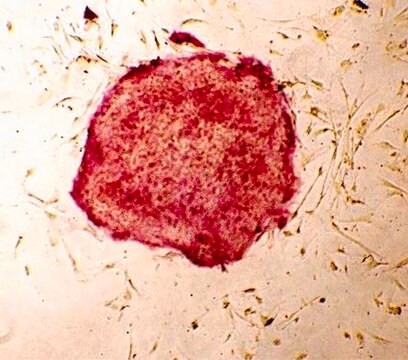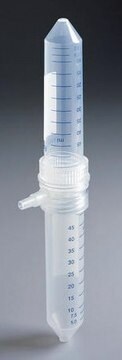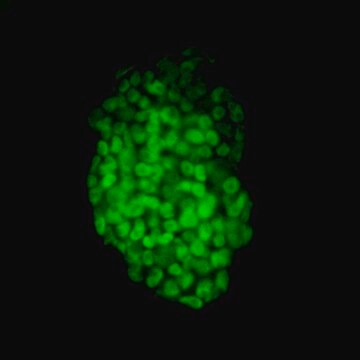SCR001
ES Cell Characterization Kit
The Embryonic Stem Cell Characterization Kit phenotypically assesses the differentiation status of ES cells by measuring their AP activity, cell-surface stage-specific antigens (SSEA-1, SSEA-4) as well as expression of TRA-1-60, TRA-1-81 antigens.
Sign Into View Organizational & Contract Pricing
All Photos(3)
About This Item
UNSPSC Code:
12161503
eCl@ss:
32161000
NACRES:
NA.43
Recommended Products
Quality Level
species reactivity
human, mouse, rat
manufacturer/tradename
Chemicon®
technique(s)
cell culture | stem cell: suitable
immunocytochemistry: suitable
input
sample type: human embryonic stem cell(s)
sample type: mouse embryonic stem cell(s)
sample type induced pluripotent stem cell(s)
shipped in
wet ice
General description
The ES Cell Characterization Kit consists of two components used for alkaline phosphatase activity determination as well as four ES cell-specific antibodies required to perform 100 tests (including controls).
INTRODUCTION
Stem cells have become the subject of extensive investigation recently, partly due to their therapeutic potential and because they raise several fundamental issues concerning the regulation of proliferation and differentiation.
Embryonic stem (ES) cells are derived from totipotent cells of the early mammalian embryo and are capable of unlimited, undifferentiated proliferation in vitro [Evans and Kaufman, 1981; Martin, 1981; Morrison, 1997]. Undifferentiated mouse ES cells can be maintained for an extensive period of time in media containing the cytokine, leukemia-inhibitory factor (LIF) or CHEMICON′s proprietary ES cell culture reagent, ESGRO® [Smith, 1988; Williams, 1988]. However, upon removal of LIF from the culture medium, in vitro, the mouse ES cells start to differentiate into cells derived from all three germ layers. In contrast, human ES cultures require mouse fibroblasts as feeder cells and cannot be maintained with LIF for self-renewal [Thomson and Marshall, 1998; Shamblott, 1988].
The undifferentiated state of the embryonic stem cell is characterized by a high level of expression of alkaline phosphatase (AP) [Pease, 1990] and the stem cell transcription factor, Oct-4. Nevertheless, these ES cells also exhibit marked differences from their murine counterparts in regards to their expression of stage-specific embryonic antigen (SSEA), that typify undifferentiated human ES and embryonic carcinoma (EC) cells.
SSEA-1, a carbohydrate antigen, is a fucosylated derivative of type 2 polylactosamine and appears during late cleavage stages of mouse embryos. It is strongly expressed by undifferentiated, murine ES cells [Solter and Knowles, 1978; Gooi, 1981]. Upon differentiation, murine ES cells are characterized by the loss of SSEA-1 expression and may be accompanied, in some instances, by the appearance of SSEA-3 and SSEA-4 [Solter, 1979]. In contrast, human ES and EC cells typically express SSEA-3 and SSEA-4 but not SSEA-1, while their differentiation is characterized by downregulation of SSEA-3 and SSEA-4 and an upregulation of SSEA-1 [Andrews, 1984; Fenderson and Andrews; 1987]. Undifferentiated, human ES cells also express the keratin sulphate-associated antigens, TRA-1-60 and TRA-1-81 [Andrews and Banting, 1984].
CHEMICON′s ES Cell Characterization Kit (Catalog number SCR001) is a specific and sensitive tool for the phenotypic assessment of the differentiation status of ES cells by measuring their AP activity, cell-surface stage-specific antigens (SSEA-1, SSEA-4) as well as expression of TRA-1-60, TRA-1-81 antigens.
INTRODUCTION
Stem cells have become the subject of extensive investigation recently, partly due to their therapeutic potential and because they raise several fundamental issues concerning the regulation of proliferation and differentiation.
Embryonic stem (ES) cells are derived from totipotent cells of the early mammalian embryo and are capable of unlimited, undifferentiated proliferation in vitro [Evans and Kaufman, 1981; Martin, 1981; Morrison, 1997]. Undifferentiated mouse ES cells can be maintained for an extensive period of time in media containing the cytokine, leukemia-inhibitory factor (LIF) or CHEMICON′s proprietary ES cell culture reagent, ESGRO® [Smith, 1988; Williams, 1988]. However, upon removal of LIF from the culture medium, in vitro, the mouse ES cells start to differentiate into cells derived from all three germ layers. In contrast, human ES cultures require mouse fibroblasts as feeder cells and cannot be maintained with LIF for self-renewal [Thomson and Marshall, 1998; Shamblott, 1988].
The undifferentiated state of the embryonic stem cell is characterized by a high level of expression of alkaline phosphatase (AP) [Pease, 1990] and the stem cell transcription factor, Oct-4. Nevertheless, these ES cells also exhibit marked differences from their murine counterparts in regards to their expression of stage-specific embryonic antigen (SSEA), that typify undifferentiated human ES and embryonic carcinoma (EC) cells.
SSEA-1, a carbohydrate antigen, is a fucosylated derivative of type 2 polylactosamine and appears during late cleavage stages of mouse embryos. It is strongly expressed by undifferentiated, murine ES cells [Solter and Knowles, 1978; Gooi, 1981]. Upon differentiation, murine ES cells are characterized by the loss of SSEA-1 expression and may be accompanied, in some instances, by the appearance of SSEA-3 and SSEA-4 [Solter, 1979]. In contrast, human ES and EC cells typically express SSEA-3 and SSEA-4 but not SSEA-1, while their differentiation is characterized by downregulation of SSEA-3 and SSEA-4 and an upregulation of SSEA-1 [Andrews, 1984; Fenderson and Andrews; 1987]. Undifferentiated, human ES cells also express the keratin sulphate-associated antigens, TRA-1-60 and TRA-1-81 [Andrews and Banting, 1984].
CHEMICON′s ES Cell Characterization Kit (Catalog number SCR001) is a specific and sensitive tool for the phenotypic assessment of the differentiation status of ES cells by measuring their AP activity, cell-surface stage-specific antigens (SSEA-1, SSEA-4) as well as expression of TRA-1-60, TRA-1-81 antigens.
Application
Research Category
Stem Cell Research
Stem Cell Research
The Embryonic Stem Cell Characterization Kit phenotypically assesses the differentiation status of ES cells by measuring their AP activity, cell-surface stage-specific antigens (SSEA-1, SSEA-4) as well as expression of TRA-1-60, TRA-1-81 antigens.
Components
Fast Red Violet solution (0.8g/L stock) (Part No. 90239). One 15mL bottle.
Napthol AS-BI phosphate solution (4mg/mL) in AMPD buffer (2mol/L), pH 9.5 (Part No. 90234). One 15mL bottle.
MS X SSEA-1, IgM, clone MC-480 (Part No. 90230). One vial containing 100μl of 1mg/mL monoclonal antibody.
MS X SSEA-4, IgG, clone MC-813-70 (Part No. 90231). One vial containing 100μl of 1mg/mL monoclonal antibody.
MS X TRA-1-60, IgM, clone TRA-1-60 (Part No. 90232). One vial containing 100μl of 1mg/mL monoclonal antibody
MS X TRA-1-81, IgM, clone TRA-1-81 (Part No: 90233). One vial containing 100μl of 1mg/mL monoclonal antibody.
Napthol AS-BI phosphate solution (4mg/mL) in AMPD buffer (2mol/L), pH 9.5 (Part No. 90234). One 15mL bottle.
MS X SSEA-1, IgM, clone MC-480 (Part No. 90230). One vial containing 100μl of 1mg/mL monoclonal antibody.
MS X SSEA-4, IgG, clone MC-813-70 (Part No. 90231). One vial containing 100μl of 1mg/mL monoclonal antibody.
MS X TRA-1-60, IgM, clone TRA-1-60 (Part No. 90232). One vial containing 100μl of 1mg/mL monoclonal antibody
MS X TRA-1-81, IgM, clone TRA-1-81 (Part No: 90233). One vial containing 100μl of 1mg/mL monoclonal antibody.
Storage and Stability
When stored at 2-8º C, the kit components are stable up to the expiration date. Do not freeze or expose to elevated temperatures. Discard any remaining reagents after the expiration date.
Legal Information
CHEMICON is a registered trademark of Merck KGaA, Darmstadt, Germany
ESGRO is a registered trademark of Merck KGaA, Darmstadt, Germany
Disclaimer
Unless otherwise stated in our catalog or other company documentation accompanying the product(s), our products are intended for research use only and are not to be used for any other purpose, which includes but is not limited to, unauthorized commercial uses, in vitro diagnostic uses, ex vivo or in vivo therapeutic uses or any type of consumption or application to humans or animals.
Signal Word
Warning
Hazard Statements
Precautionary Statements
Hazard Classifications
Carc. 2 - Eye Irrit. 2 - Skin Irrit. 2
Storage Class Code
10 - Combustible liquids
Certificates of Analysis (COA)
Search for Certificates of Analysis (COA) by entering the products Lot/Batch Number. Lot and Batch Numbers can be found on a product’s label following the words ‘Lot’ or ‘Batch’.
Already Own This Product?
Find documentation for the products that you have recently purchased in the Document Library.
Ji-Hye Jung et al.
Stem cells and development, 25(13), 1006-1019 (2016-05-18)
On the basis of our previous report verifying that chemokine (C-X-C motif) receptor 2 (CXCR2) ligands in human placenta-derived cell conditioned medium (hPCCM) support human pluripotent stem cell (hPSC) propagation without exogenous basic fibroblast growth factor (bFGF), this study was
Sumitha Prameela Bharathan et al.
Biology open, 6(1), 100-108 (2017-01-17)
Low efficiency of somatic cell reprogramming and heterogeneity among human induced pluripotent stem cells (hiPSCs) demand extensive characterization of isolated clones before their use in downstream applications. By monitoring human fibroblasts undergoing reprogramming for their morphological changes and expression of
Aba Somers et al.
Stem cells (Dayton, Ohio), 28(10), 1728-1740 (2010-08-18)
The development of methods to achieve efficient reprogramming of human cells while avoiding the permanent presence of reprogramming transgenes represents a critical step toward the use of induced pluripotent stem cells (iPSC) for clinical purposes, such as disease modeling or
Anthony Zulli et al.
Experimental physiology, 93(5), 564-569 (2008-01-15)
Angiotensin-converting enzyme 2 (ACE2) is a novel enzyme with possible implications in the treatment of blood pressure disorders. Recent evidence suggests that an upregulation of ACE2 can be stimulated by all-trans retinoic acid (at-RA); however, at-RA also affects regulation of
Yogish C Kudva et al.
Stem cells translational medicine, 1(6), 451-461 (2012-12-01)
The induced pluripotent stem cell (iPSC) technology enables derivation of patient-specific pluripotent stem cells from adult somatic cells without using an embryonic cell source. Redifferentiation of iPSCs from diabetic patients into pancreatic islets will allow patient-specific disease modeling and autologous
Our team of scientists has experience in all areas of research including Life Science, Material Science, Chemical Synthesis, Chromatography, Analytical and many others.
Contact Technical Service










